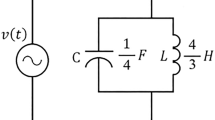Abstract
Continuing the work of S. Fryze and C.I. F. Budeanu, we examined the errors and contradictions in determining inactive capacities. The errors and contradictions were caused by the formal extrapolation of the symbolic method onto electric circuits with non-sine-wave currents and voltages. This article shows that the testing of operational modes of non-sine-wave single-phase ac mains requires representing voltages and currents on a complex plane as generalized vectors for which it is necessary to determined paired projections on orthogonal axes.



Similar content being viewed by others
REFERENCES
Steinmetz, C.P., Theoretische Grundlagen der Starkstromtechnik, Braunschweig: Verlag von Vieweg, 1903.
Budeanu, C.I., Reactive and Fictitious Powers, Bucharest: Natl. Roman. Inst. Energy, 1927, no. 2.
Czarnecki, L.S., What is wrong with the Budeanu concept of reactive and distortion power and why it should be abandoned, IEEE Trans. Instrum. Meas., 1987, vol. 36, no. 3.
Fryze, S., Active, reactive and apparent powers in circuits with distorted voltages and currents, Elektrotechnische Zeitschrift, ETZ, 1932, vol. 53, no. 25.
Kusters, N.L. and Moore, W.J.M., On the definition of reactive power under non-sinusoidal conditions, IEEE Trans. Power Appl. Syst., vol. PAS-99, no. 5.
Czarnecki, L.S.,Scattered and reactive current, voltage and power in circuits with non-sinusoidal waveforms and their compensation, IEEE Trans. Instrum. Meas., 1991, vol. 40, no. 3.
Sirotin, Yu.A., Orthogonal components of three-phase current during asymmetric active-reactive load in a four-wire circuit, Elektrotekh. Eletromekh., 2016, no. 3.
Buchholtz, F., Das Begriffssystem Rechtleistung, Wirkleistung, Totale Blindleistung, Munich: Selbstverlag, 1950.
Depenbrock, M., The FBD-Methods a generally applicable tool for analyzing power relations, IEEE Trans. Power Syst., 1993, vol. 8, no. 2.
Akagi, H. and Nabae, A., The p-q theory in three-phase systems under non-sinusoidal conditions, Eur. Trans. Electr. Power, 1993, vol. 3.
Willems, J.L., A new interpretation of the Akagi-Nabae power components for non-sinusoidal three-phase situations, IEEE Trans. Instrum. Meas., 1992, vol. 41, no. 4.
Ferrero, A., Morando, A.P., Ottoboni, R., and Superti-Furga, G., On the Meaning of the Park power components in three-phase systems under non-sinusoidal conditions, Eur. Trans. Electr. Power, 1993, vol. 3, no. 1.
O’Rourke, C.J., et al., A geometric interpretation of reference frames and transformations: dq0, Clarke, and Park, IEEE Trans. Energy Convers., 2019, vol. 34, no. 4.
Jeltsema, D., Budeanu’s concept of reactive and distortion power revisited, Przegl. Elektrotech., 2016, vol. 92, no. 4.
Myatezh, S.V., Novolodskiy, M.V., and Kitova, E.T., Definition of distortion power in AC network and analysis of its reasons, IOP Conf. Ser.: Mater. Sci. Eng., 2019, vol. 560.
Author information
Authors and Affiliations
Corresponding author
Additional information
Translated by S. Kuznetsov
About this article
Cite this article
Myatezh, S.V., Shchurov, N.I., Shtang, A.A. et al. Development of the Theory of Determining Inactive Capacities in Non-Sine-Wave Single-Phase AC Mains. Russ. Electr. Engin. 92, 332–337 (2021). https://doi.org/10.3103/S1068371221060092
Received:
Revised:
Accepted:
Published:
Issue Date:
DOI: https://doi.org/10.3103/S1068371221060092



